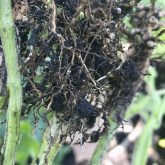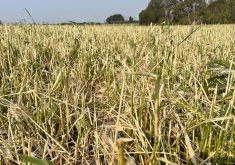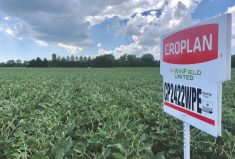You can’t accuse Ernie Sirski of doing things by halves. In fact, he does them by twos, at least when it comes to soybeans.
In 2012, Sirski planted 200 acres of soybeans for the first time on his farm near Dauphin, Man. The next year, he doubled that to 400 acres, averaging an impressive 40 bushels an acre. This spring, despite cool, wet conditions which delayed seeding, Sirski planted 800 acres of soybeans, nearly a quarter of his 3,600 acres of cropland.
That’s still less than his acreage for wheat and canola. But consider this. Sirski’s year-over-year doubling of soybean acres is happening in northwestern Manitoba, four hours from Winnipeg, where soybeans until now have barely been on the radar screen as a commercial crop.
Read Also

Could crop sharing be a viable option for your farm?
Crop sharing could be a good option for young and beginning farmers.
From a marginal crop hugging the Canada-U.S. border, soybeans have begun surging across Manitoba well beyond the Red River Valley, where roughly 80 per cent of the province’s soybeans are still grown. Non-traditional regions include places where soybeans would hardly have been considered a few years back. According to the Manitoba Agricultural Services Corporation’s harvest production report, the two areas of the province where soybeans expanded the most in 2013 were Dauphin, Sirski’s home municipality where yields averaged 36 bushels an acre, and the regional municipality of Bifrost in Manitoba’s Interlake region.
- More on soybeans from Country Guide: All in a days’ work
What’s remarkable is the extent to which Manitoba’s soybean acreage has expanded in a short time. Since 2011, when Statistics Canada predicted Manitoba farmers would seed 575,000 acres of soybeans, plantings have increased by 225,000 to 250,000 acres annually.
In 2014, StatsCan said Manitoba farmers planted an almost unbelievable 1.3 million acres of soybeans, a 24 per cent increase from 2013.
Next door in Saskatchewan, the acreage, although much smaller, has grown even more rapidly. In 2013, for the first time ever, StatsCan included soybeans in its spring planting intentions for the province. The figure was 170,000 acres. This past spring, growers nearly doubled the crop, planting 300,000 acres there.
Overnight, Saskatchewan has become Canada’s fourth-largest soybean producer, ahead of Prince Edward Island. That’s quite an achievement for a crop which seems to have come from nowhere in a province where wheat is traditionally king.
Normally associated with southern Ontario and the U.S. Midwest, soybeans are relatively new to Western Canada, and it’s fair to say their rapid rise has some farmers rubbing their eyes and wondering: is this for real?
Apparently so. From a minor crop 10 years ago, soybeans today are Manitoba’s third-largest crop behind wheat and canola. Last year the provincial average yield for soybeans was 39 bushels an acre, up from 36 bushels in 2012 and well above the 10-year average of 30 bushels.

There are two reasons for soybeans’ recent success. In the field, the arrival of early-maturing varieties has made them more commercially feasible. Meanwhile, strong prices and steady market demand have notched up the incentive for growers to give them a chance.
Not that long ago, the only soybean varieties available to Manitoba farmers were late maturing, which limited their viability during the province’s relatively short growing season. Since the early 2000s, however, the development of earlier-maturing varieties better suited to local growing conditions has helped the rapid expansion of soybean acres in Manitoba and even farther west.
“Genetics have brought us a long way, as far as shortening maturity,” says Kristen Podolsky, production specialist for the Manitoba Pulse Growers Association. “That’s led us into this progression and it’s going to continue.
“My No. 1 concern about limitation may come down to variability in weather and climate,” Podolsky says.
Ah, yes, weather and climate — two factors which could yet send a promising crop into a tailspin. Even though some soybean boosters tout Manitoba as the next Iowa, the fact remains that growing conditions north of the 49th parallel are different from those to the south.
Although new improved varieties have reduced the number of days to maturity, soybeans are still a late-season crop. Producers harvest them in September, and there’s no way around that. That makes soybeans more vulnerable to an early frost than some other crops. And in Western Canada frost can and does come early while unharvested crops are still in the field. The average date for the first fall frost in Winnipeg is around September 21. Near Dauphin, where Sirski farms, it’s more like September 12.
For that reason, farmers must seriously consider if they want to play dice with Mother Nature before going into soybeans, says Dennis Lange, a farm production adviser specializing in pulse crops for the Manitoba Agriculture Ministry.
“When they’re planting soybeans, they have to realize it is a late-season crop,” Lange says. “At the end of the day, if they realize there’s potential for a frost in September and beans aren’t going to be mature at that time, they might rethink how many acres they’ll grow in the future.”
Soybeans can be a pretty forgiving crop, able to withstand both wet and hot conditions reasonably well. But even they have their limits. Soybeans require enough precipitation in early August to set seed. If they don’t get it on time (as happened in western Saskatchewan in 2013), yields are affected. Manitoba growers also remember 2004 as the year with no summer which saw cool weather, lots of rain and a killing frost in August. The average provincial soybean yield that year was just eight bushels an acre.
Since then, for the most part, growers have dodged the weather bullet. True, the last two years have seen cool, wet weather in spring, which delayed seeding. But a series of late, warm autumns extended crop development and stretched harvesting into late September and even early October.
Favourable fall weather and earlier-maturing varieties are the two main reasons for successful soybean crops in recent years, says Lange.
“We haven’t had any detrimental weather in fall, like an early frost in September. Things have been moving along, and growers have been quite successful at choosing varieties that are suited for their region,” Lange adds. “Part of our expansion has just been due to the fact that we’ve seen some good varieties come along, we’ve seen some good yields, and the weather has co-operated.”
Podolsky believes soybeans are still a high-risk crop on the Prairies, despite advances in genetics. For that reason, she says producers need to consider multiple agronomic factors when selecting a soybean variety, as producers do in any region. But one factor overrides them all: days to maturity.
“Growers should really focus on information about days to maturity because it takes into account all the factors,” Podolsky says. “Regardless of how it gets to maturity, it’s really the number of days it takes that matters.”
Martin Entz, a University of Manitoba plant scientist who specializes in sustainable agriculture, observes that soybeans still represent a small acreage in Western Canada and will probably never rival wheat and canola. But because it’s a commercially viable legume crop, which fixes its own nitrogen, soybeans can be a good fit in crop rotations.
“The real benefit of soybeans is that they allow a warm-season crop into our rotations,” says Entz. “That gives us some risk management options because canola is very much a cool-season crop. If we have both canola and soybeans on the farm and if we get a cool year, the canola will respond. And if we have a hot year, the soybeans will respond.”
But Entz warns against using soybeans to replace other crops.
“If we’re just going to move from a canola-wheat rotation to a soybean-wheat rotation, then perhaps we haven’t made any progress,” Entz says.
Entz also expresses concern about what soybeans may do to zero- or minimum-tillage systems. Soybeans require warm soil to germinate, and some growers have been known to abandon zero till and cultivate soils black in order to warm up the ground faster.
“That can really come back to hurt us,” Entz says. “Farmers need to think really carefully about that.”
Another concern is the fact that most soybean varieties grown in Manitoba are glyphosate resistant. Entz warns that, with the arrival of second-generation Roundup Ready soybeans, the continuous use of glyphosate will create greater selection pressure and increase the presence of glyphosate-resistant weeds. A rotation which also contains Roundup Ready canola only adds to the risk.
While welcoming the arrival of soybeans in the West, Entz says it should be seen mainly as an opportunity to diversify crop rotations. He encourages producers to approach soybeans carefully and not to treat them as a new Cinderella crop.
“If you grow some, get some experience with it. Grow varieties that are suited to your length of season,” Entz says. “And if there are no varieties suited to your length of season, maybe you should be considering whether you even want to grow them.”
This article was originally published as a special supplement ‘Soybean Guide,’ in the October 2014 issue of Country Guide















